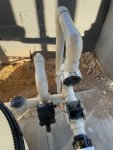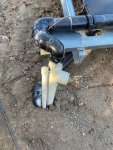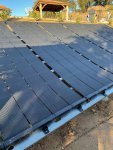Hmm, I'll start with the easy answers...
Yes, the ET will control that 3-way to turn on and off the solar heater. You'll need to install an actuator on the three-way, and two temp sensors. One near the panels (which measures the heat of the air/sun on the panels) and another in the plumbing, which measures the temperature of the pool water. You would install the air sensor right next to one of the panels. The water sensor would go in between the pump and the solar valve. The ET comes with the required sensors, so maybe you already have those.
Yes I would install a Jandy 3 way actuator valve.
I don't believe I have the sensors as the pool guys didn't leave any parts. Any part numbers you can share on those?
I now show them as the purple (Air sun senser) and pink (Temp pool water) senser? I can see the pool and spa temps on the ET and phone app I just need to see where we are reading that from asht epool has 7 pumps.

You need a check valve on the pipe returning from the panels. That keeps water from flowing into the panels when the three-way valve is in the solar-off position. In your case, that would be doing its job whether the filter pump was on or off, because your panels are below the pool. You don't need the check valve on the supply side of the panels, the three-way valve serves that purpose. You want water flowing toward the panels when the system is heating, and the three-way will prevent flow in either direction in its solar-off position.
Got it I think this is now correct. Blue is feed and Red is return.

You didn't plot where your filter is. Typically there is a check valve between the filter and the solar three-way, which keeps "solar panel water" from back-flowing into the filter. That's seen in systems where the panels are above the pool. We'll come back to that. The panels should be
after the the filter, so only filtered water goes into them.
Added Filter here. So yes filtered water into solar.

Regarding back-flowing into the heaters: typically the return from the panels comes back into the pipe that leads
into the heaters, not the way you have it. That would solve the back-flow issue. It would also allow the gas heaters to heat the solar-heated water. That would be more efficient, and get you to a desired temp quicker if you were heating up the spa during sunlight hours.
I understand and I think I fixed it now.

Now the kicker is, I don't have any experience, nor have I read or studied how to plumb panels that are
below the pool. The inherent problem is that the panels should be able to drain after the heating session is done. You don't want water sitting in the panels overnight, because the first thing you'll do the next day is pump a bunch of cold water into your pool. This is especially important if temps get to freezing at night where you live, because the expanded frozen water could destroy the panels.
I put in a call to Helocoil and will ask. I live in San Diego and not often does it get that cold. But I understand what your saying. Possible I can set this pump to come on after its had a little time to warm up a bit and then start moving water. Say 10am and then run it a little later into the night. I asumed hilliside install was ok as I found this picture when I looked up the helocoil panels and this came up.
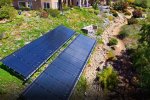
Typically, the solar valve is not a normal three-way. You use a "solar drain-down" three-way, which allows water from the panels to drain down into the pool once the filter pump shuts down for the day. And there is a vacuum-relief valve installed to allow air into the panels so they can drain properly. But... I have no idea how to accomplish that when the panels are below the pool surface. I suppose you could leave the water in the panels for most of the days of the year, and then drain them before winter. You'd install a hose bib or two in the panel plumbing for that purpose. But that would be a manual task. You'd be wasting all that water if you did that daily during the colder months. Not too bad if done just once a year. If it never gets that cold down south where you are, maybe this is a non issue.
Ill ask about this as well. But good thoughts here.
If you schedule the solar heat to only turn on later in the morning, then the water would heat up enough to negate the issue I described previously: so no sending a blast of cool water into your pool at start up.
Yes I agree and good thoughts.
There may be other issues in leaving water in the panels 24/7 that I don't know about. I know my panels hold water from about 8am to 4pm, even if the solar valve goes back to the solar-off position (like when the sun goes behind a cloud, or the pool reaches the desired temp).
Ill ask and let everyone know what Helocoil says.
The ET turns the three-way valve open/closed throughout the day if need be, depending on the pool temp and the temp at the panels. It can also control which heating system to use, based on which is available at any given point during the day or night. Since I've never used my gas heater, I'm not sure if the ET will allow both systems to be on at the same time.
Another consideration: typically the supply line feeds the lower end of the panels, the water runs upward through them, and exits the panels at their highest point. But I'm not sure if that applies to your situation. The skew of the panels relative to gravity is also important, so that the system heats most efficiently.
Yes thats the way I drew it as well. Cold was the suppply side and red was the heated on top back to pool.
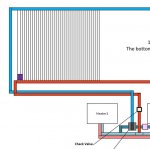
Anywho, you should call Heliocol support and describe your situation to determine if there is any harm (other than the freezing I described) in allowing water to remain in the panels 24/7. They may be able to suggest the proper way to plumb your panels. Then go from there. Or figure out a way to elevate the panels to be above the pool surface.












